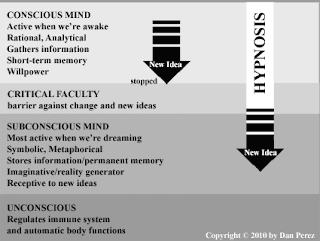 |
| Hypnosis allows access into the subconscious mind. |
Hypnosis, while effective in memory recall, is also prone to
false memories.
While many individuals have successfully recalled memories
they thought had been forgotten, false memories are also common. Because of
this, in 1984 the American Medical Association stated that hypnosis does not
produce reliable recall. Even though the process of hypnosis can help a person remember
additional details, there is no way of determining what is and is not accurate.
Tom Mauriello, Forensics Professor at University of Maryland and certified
hypnotist, was able to hypnotize students in in his criminal justice class and
have them remember the names of their first grade teachers, which they had
forgotten before hypnosis. He does admit that occasionally participants recall
false information. Mauriello is certified as a hypnotist by the International
Investigative Hypnosis Institute. In the video below, Mauriello describes how
memories retrieved through hypnosis can be more accurate.
He emphasizes the fact that hypnosis allows the subject to recall events without emotional distortion, which can be very helpful for victims and witnesses of traumatic experiences. Hypnosis, however, remains controversial as a means for memory recall. A study by the University of Pennsylvania found that hypnosis did not produce a greater increase in accurate memory recall as compared with attempts of recall with subjects that had not undergone hypnosis.
There are no clear guidelines for hypnotically obtained
testimony and evidence in court.
Because of its controversial nature, the admissibility of testimony and evidence
retrieved through hypnosis currently varies by jurisdiction. There is no universal
decision on whether or not hypnosis is acceptable method for uncovering the
truth. In jurisdictions where it is allowed but questioned, there are many
criteria for reliability that the process must meet. These courts will often use procedural safeguards to ensure reliability and credibility of the testimony. In three states, it is
completely inadmissible, and in four states it is completely admissible. The
rest of the states have varying degrees of regulations, which shows just how
divided an issue it is. In 1987 the United States Supreme Court ruled that states may not absolutely prohibit defendants from testifying about details obtained from hypnotic memory call. The Court recognizes that the recall may be inaccurate, but states that prohibiting it infringes on the constitutional rights of the defendant. They, however, issued no ruling on hypnotically obtained testimony from witnesses. This ruling conflicted with some states' ban on testimony from hypnosis that were already in place.
Hypnosis has been and can continue to be a productive aid in criminal
investigations.
While it may not admissible in court in certain jurisdictions, hypnosis can be helpful in investigations by hypnotizing both victims and
witnesses. Hypnosis allows for the participant to recall traumatic events
without emotional interference. Famous cases where hypnosis has been used are
that of Ted Bundy, Sam Sheppard, and the Boston Strangler.Another example of successful application of hypnosis in the criminal justice system is the Chowchilla case of 1976 in which a bus driver was able to recall two digits of a license plate after being buried alive with twenty six school children. Using this information, the kidnappers were found and prosecuted. Mauriello believes that if done correctly, hypnosis should definitely be used in criminal investigations and court.
General Psychology lists three criteria for acceptable testimony from hypnosis in the courtroom;
1. Uses corroborating evidence.
2. Avoids leading questions.
3. Used only when needed.
These criteria are supported by Mauriello and a study of 42 eyewitnesses which found that inaccuracies in testimonies stemmed from leading questions. The study also found that hypnosis should be limited to eyewitnesses and used as a last resort. With these criteria, hypnosis can be an effective tool both in criminal investigations and in court.
Public misconceptions may cause hypnosis to be less effective in court.
Even with past success in criminal cases, there is still an issue that jury members may have misconceptions about the credibility of hypnosis based on the inaccurate portrayal in popular culture. Courts try to counteract this by using safeguards to increase credibility, but based on varying results from studies it may prove difficult to convince the average person of its reliability. If the jury cannot trust the method for obtaining testimony, they may disregard it or develop a bias against the witness or victim that testified. This could actually diminish the value of using hypnosis for memory recall. To illustrate this, a non-expert individual was asked his opinion on the whether or not hypnotically obtained testimony should be allowed in court.
.jpg)
.jpg)



